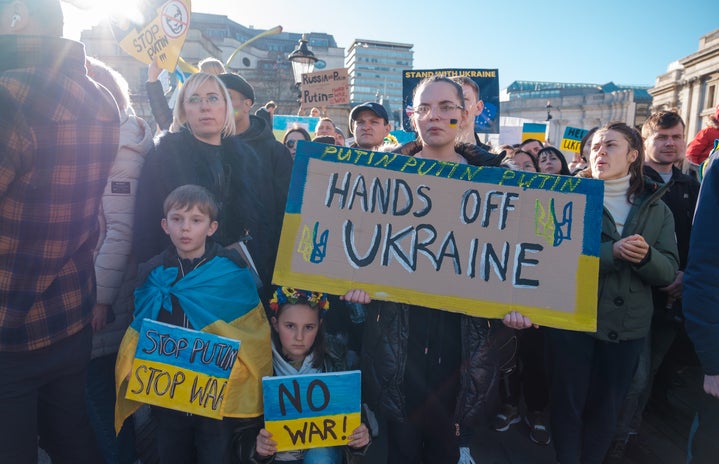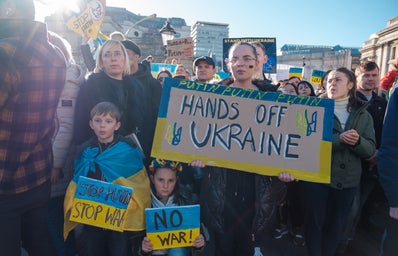What you might not know is that the war between Russia and Ukraine has actually been going on for eight years. In February 2014, Russia annexed Crimea from Ukraine and added the territory to their own country because Ukraine’s president at the time was very pro-Russia. Allegedly, the Russian government bribed this Ukrainian president to not join the European Union. This caused protests and street riots in the Ukrainian capital, Kyiv, which in turn led to a
destabilized government. Eventually, Ukraine’s president fled, and Putin was able to take his opportunity to seize Crimea for his own country. Since the ousting of Ukraine’s former president in 2014, Putin has been sharing his belief that Ukraine is run by extremists and nazis. Recently, he decided he would “free the country
from genocide,” which is a false pretense because the Ukrainian people have been generally very happy with their democratically-elected government. And there has definitely been no genocide in Ukraine. However, on February 24th, Putin announced his “special military operation,” and Russian troops began invading Ukraine. Each night since, the news has been filled with reports of war.
After the invasion began, the Ukrainian president issued a statement to the people of Russia, hoping that his message would reach them eventually through the media bans placed in their country. In his message, he hoped to convince the people of Russia that “the Ukrainian people are free” and that there is no reason for Putin to be protecting them from a genocide that doesn’t exist. Once the world recognized that war was forming, help came through on both sides. On February 25th, the U.S. sent financial aid to Ukraine in the form of security assistance, while Belarus sent troops to assist Russia’s army. There has also been speculation that China has allied with Russia, as they have been allies in the past and more recently have refused to condemn Russia’s actions. After more explosions in Kyiv on February 25th, Germany halted their work on a controversial energy project that would have used Russia’s resources, forcing the European Union to rely more on Russia. The decision to scrap this energy project, by the way, gives Europe the opportunity to strive towards diminishing its reliance on fossil fuels, but that’s a story for another day. Other countries that chose to back Ukraine include Britain, Canada, the European Union, Japan, Australia, Taiwan, and everyone’s favorite historically neutral country, Switzerland.
On March 1st, President Biden spent the first few minutes of his State of the Union Address discussing the war between Russia and Ukraine. He pointed out the importance of the nonmilitary response to Russia’s attacks coming from the west and assured us that “we are united” as allies standing against Russia. There are definitely a few people who disagree with Biden’s message, but the general consensus is that NATO’s refusal to take military action is a good thing. However, the sanctions that NATO is imposing on Russia in lieu of military action have the potential to hurt the economy around the globe. Biden’s State of the Union Address was met with both predictions about Putin’s response and stories of hope from people across the globe. Many people shared their belief that Putin would not respond, and others shared their opinion that this war would make Russia weaker and Ukraine stronger, rather than the other way around, which is what seems like what Putin wants to happen.
As Russian military forces continued to occupy more cities, the currency exchange rate for the Russian Ruble continued to decrease and citizens continued to head towards the Ukraine-Poland border in order to get out of the country. Several countries abroad responded to the violence by relocating their embassies to cities further away from the capital. On March 2nd, the mayor of one of the Russian-occupied cities, Kherson, stated that Ukrainian
forces had left their city and that the Russian military had started controlling the daily lives of Ukrainian
citizens. Though British military intelligence stated at the time that the situation remained unclear, the mayor’s rhetoric indicated that the city had fallen.
Late March 3rd, one of the 15 nuclear power plants in Ukraine was set on fire due to heavy shooting from Russian forces. The Ukrainian president made a statement on Facebook reminding the world of the Chernobyl disaster and the catastrophe that could follow if one of Ukraine’s nuclear power plants blew up. In total, Ukraine has 15 nuclear power plants. If one of them explodes, it could set the others off as well, destroying a large portion of Europe. Luckily, on early March 4th the fire was put out.
Later that day, more sanctions were placed on Russia by countries including Singapore, and a visa program granting Ukrainian refugees access to life and work was established in Brazil. The United States spent the day exercising their bomber planes over NATO with Germany and Romania. Meanwhile, NATO officials who continued to observe the war concluded that the Russian military seems that they might begin to “bombard cities into submission,” resulting in more casualties. The Ukrainian president responded to this with frustration that NATO had not yet imposed the no-fly zone he had requested, claiming that they could have stopped the Kremlin from bombing several spots in Ukraine. However, several NATO officials believe that by fulfilling the Ukrainian president’s request for a no-fly zone, they would be declaring war on Russia, which is the last thing NATO wants to do. As the war continued, countries began to ban imports of Russian oil, and big corporations also began to ban imports of other Russian products. On March 9, to the surprise of the rest of the world, Poland proposed sharing their fighter jets with Ukraine via a U.S. Military base. The U.S. responded by sending Vice President Kamala Harris to Poland to discuss the reasons why it would not be plausible to send over the planes. Meanwhile, foreign ministers of Russia and
Ukraine also met to discuss things on Thursday, March 10. As Russian troops closed in closer on Ukraine’s capital, “strong Ukrainian resistance” helped to hold them back from Kyiv and other cities.
Over the weekend, the Ukrainian President continued to position for NATO to fast-track Ukraine’s application, but NATO refused to make the exception he wanted. On March 12, the NATO secretary-general warned Ukraine that Russia might begin using chemical weapons, urging them to quickly dispose of pathogens stored in laboratories for testing in order to not allow Russia to steal them and use them as weapons. Also, remember that nuclear power plant that Russian troops set on fire? They’re now planning to take full control over it. Meanwhile, the U.S. government is sending $200 million more dollars to aid the Ukrainian military, while the Kremlin is running out of troops and Putin is beginning to enlist mercenaries (widely from middle eastern countries) to help fight his war.
As the war continues to unfold, people like the Pope are begging for the massacre to stop and are urging more countries to take in refugees. The White House is working with TikTokers to spread information on the war, and the official Ukraine Twitter account is posting memes hoping to reach people and convince them to sympathize with Ukraine. No matter how you choose to respond or help if you choose to do so, what we can all conclude is that this moment in time is very important to our history.


